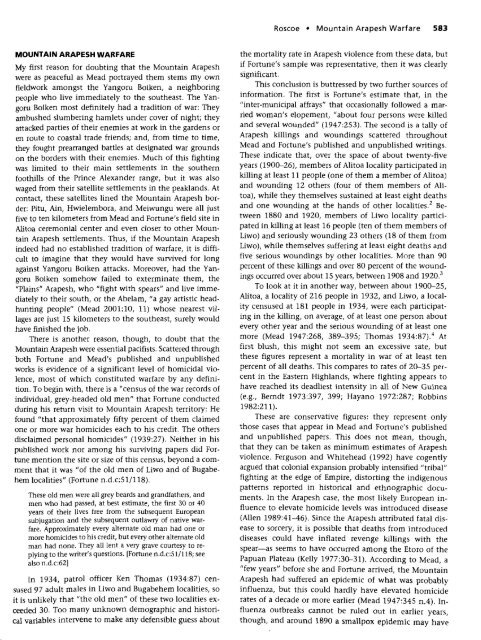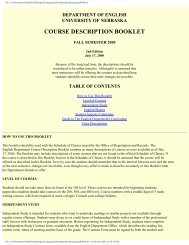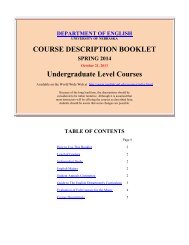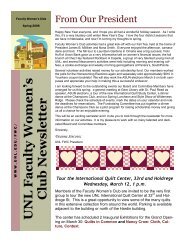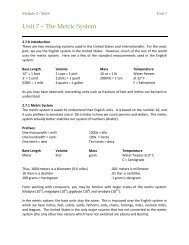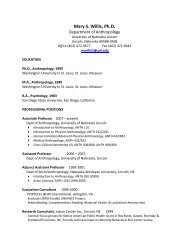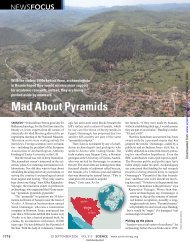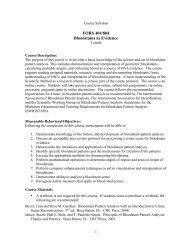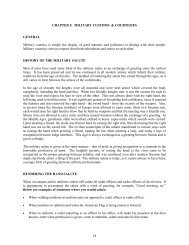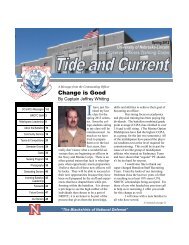Margaret Mead, Reo Fortune, and Mountain Arapesh Warfare
Margaret Mead, Reo Fortune, and Mountain Arapesh Warfare
Margaret Mead, Reo Fortune, and Mountain Arapesh Warfare
Create successful ePaper yourself
Turn your PDF publications into a flip-book with our unique Google optimized e-Paper software.
MOUNTAIN ARAPESH WARFARE<br />
My first reason for doubting that the <strong>Mountain</strong> <strong>Arapesh</strong><br />
were as peaceful as <strong>Mead</strong> portrayed them stems my own<br />
fieldwork amongst the Yangoru Boiken, a neighboring<br />
people who live immediately to the southeast. The Yangoru<br />
Boiken most definitely had a tradition of war: They<br />
ambushed slumbering hamlets under cover of night; they<br />
attacked parties of their enemies at work in the gardens or<br />
en route to coastal trade friends; <strong>and</strong>, from time to time,<br />
they fought prearranged battles at designated war grounds<br />
on the borders with their enemies. Much of this fighting<br />
was limited to their main settlements in the southern<br />
foothills of the Prince Alex<strong>and</strong>er range, but it was also<br />
waged from their satellite settlements in the peakl<strong>and</strong>s. At<br />
contact, these satellites lined the <strong>Mountain</strong> <strong>Arapesh</strong> border:<br />
Pitu, Ain, Hwielembora, <strong>and</strong> Meiwungu were all just<br />
five to ten kilometers from <strong>Mead</strong> <strong>and</strong> <strong>Fortune</strong>'s field site in<br />
Alitoa ceremonial center <strong>and</strong> even closer to other <strong>Mountain</strong><br />
<strong>Arapesh</strong> settlements. Thus, if the <strong>Mountain</strong> <strong>Arapesh</strong><br />
indeed had no established tradition of warfare, it is difficult<br />
to imagine that they would have survived for long<br />
against Yangoru Boiken attacks. Moreover, had the Yangoru<br />
Boiken somehow failed to exterminate them, the<br />
"Plains" <strong>Arapesh</strong>, who "fight with spears" <strong>and</strong> live immediately<br />
to their south, or the Abelam, "a gay artistic headhunting<br />
people" (<strong>Mead</strong> 2001:10, 11) whose nearest villages<br />
are just 15 kilometers to the southeast, surely would<br />
have finished the job.<br />
There is another reason, though, to doubt that the<br />
<strong>Mountain</strong> <strong>Arapesh</strong> were essential pacifists. Scattered through<br />
both <strong>Fortune</strong> <strong>and</strong> <strong>Mead</strong>'s published <strong>and</strong> unpublished<br />
works is evidence of a significant level of homicidal violence,<br />
most of which constituted warfare by any definition.<br />
To begin with, there is a "census of the war records of<br />
individual, grey-headed old men" that <strong>Fortune</strong> conducted<br />
during his return visit to <strong>Mountain</strong> <strong>Arapesh</strong> territory: He<br />
found "that approximately fifty percent of them claimed<br />
one or more war homicides each to his credit. The others<br />
disclaimed personal homicides" (1939:27). Neither in his<br />
published work nor among his surviving papers did <strong>Fortune</strong><br />
mention the site or size of this census, beyond a comment<br />
that it was "of the old men of Liwo <strong>and</strong> of Bugabehem<br />
localities" (<strong>Fortune</strong> n.d.c:51/118).<br />
These old men were all grey beards <strong>and</strong> gr<strong>and</strong>fathers, <strong>and</strong><br />
men who had passed, at best estimate, the first 30 ot 40<br />
years of their lives free from the subsequent European<br />
subjugation <strong>and</strong> the subsequent outlawry of native warfare.<br />
Approximately every alternate old man had one or<br />
more homicides to his credit, but every other alternate old<br />
man had none. They all lent a very grave courtesy to replying<br />
to the writer's questions. [<strong>Fortune</strong> n.d.c:51/118; see<br />
also n.d.c:62]<br />
In 1934, patrol officer Ken Thomas (1934:87) censused<br />
97 adult males in Liwo <strong>and</strong> Bugabehem localities, so<br />
it is unlikely that "the old men" of these two localities exceeded<br />
30. Too many unknown demographic <strong>and</strong> historical<br />
variables intervene to make any defensible guess about<br />
Roscoe • <strong>Mountain</strong> <strong>Arapesh</strong> <strong>Warfare</strong> 583<br />
the mortality rate in <strong>Arapesh</strong> violence from these data, but<br />
if <strong>Fortune</strong>'s sample was representative, then it was clearly<br />
significant.<br />
This conclusion is buttressed by two further sources of<br />
information. The first is <strong>Fortune</strong>'s estimate that, in the<br />
"inter-municipal affrays" that occasionally followed a married<br />
woman's elopement, "about four persons were killed<br />
<strong>and</strong> several wounded" (1947:253). The second is a tally of<br />
<strong>Arapesh</strong> killings <strong>and</strong> woundings scattered throughout<br />
<strong>Mead</strong> <strong>and</strong> <strong>Fortune</strong>'s published <strong>and</strong> unpublished writings.<br />
These indicate that, over the space of about twenty-five<br />
years (1900-26), members of Alitoa locality participated in<br />
killing at least 11 people (one of them a member of Alitoa)<br />
<strong>and</strong> wounding 12 others (four of them members of Alitoa),<br />
while they themselves sustained at least eight deaths<br />
<strong>and</strong> one wounding at the h<strong>and</strong>s of other localities. 2 Between<br />
1880 <strong>and</strong> 1920, members of Liwo locality participated<br />
in killing at least 16 people (ten of them members of<br />
Liwo) <strong>and</strong> seriously wounding 23 others (18 of them from<br />
Liwo), while themselves suffering at least eight deaths <strong>and</strong><br />
five serious woundings by other localities. More than 90<br />
percent of these killings <strong>and</strong> over 80 percent of the woundings<br />
occurred over about 15 years, between 1908 <strong>and</strong> 1920. 3<br />
To look at it in another way, between about 1900-25,<br />
Alitoa, a locality of 216 people in 1932, <strong>and</strong> Liwo, a locality<br />
censused at 181 people in 1934, were each participating<br />
in the killing, on average, of at least one person about<br />
every other year <strong>and</strong> the serious wounding of at least one<br />
more (<strong>Mead</strong> 1947:268, 389-395; Thomas 1934:87). 4 At<br />
first blush, this might not seem an excessive rate, but<br />
these figures represent a mortality in war of at least ten<br />
percent of all deaths. This compares to rates of 20-35 percent<br />
in the Eastern Highl<strong>and</strong>s, where fighting appears to<br />
have reached its deadliest intensity in all of New Guinea<br />
(e.g., Berndt 1973:397, 399; Hayano 1972:287; Robbins<br />
1982:211).<br />
These are conservative figures: they represent only<br />
those cases that appear in <strong>Mead</strong> <strong>and</strong> <strong>Fortune</strong>'s published<br />
<strong>and</strong> unpublished papers. This does not mean, though,<br />
that they can be taken as minimum estimates of <strong>Arapesh</strong><br />
violence. Ferguson <strong>and</strong> Whitehead (1992) have cogently<br />
argued that colonial expansion probably intensified "tribal"<br />
fighting at the edge of Empire, distorting the indigenous<br />
patterns reported in historical <strong>and</strong> ethnographic documents.<br />
In the <strong>Arapesh</strong> case, the most likely European influence<br />
to elevate homicide levels was introduced disease<br />
(Allen 1989:41-46). Since the <strong>Arapesh</strong> attributed fatal disease<br />
to sorcery, it is possible that deaths from introduced<br />
diseases could have inflated revenge killings with the<br />
spear—as seems to have occurred among the Etoro of the<br />
Papuan Plateau (Kelly 1977:30-31). According to <strong>Mead</strong>, a<br />
"few years" before she <strong>and</strong> <strong>Fortune</strong> arrived, the <strong>Mountain</strong><br />
<strong>Arapesh</strong> had suffered an epidemic of what was probably<br />
influenza, but this could hardly have elevated homicide<br />
rates of a decade or more earlier (<strong>Mead</strong> 1947:345 n.4). Influenza<br />
outbreaks cannot be ruled out in earlier years,<br />
though, <strong>and</strong> around 1890 a smallpox epidemic may have


